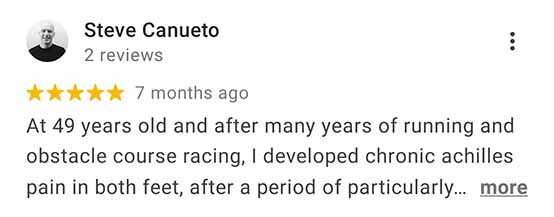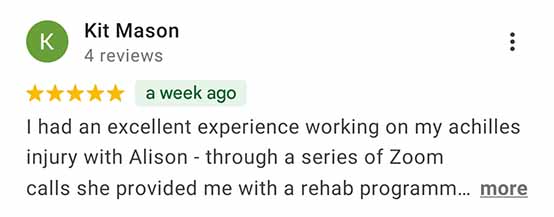Don't confuse heel drop exercises for Achilles tendonitis with stretching!
- Maryke Louw
- Nov 26, 2021
- 6 min read
Updated: Nov 15, 2024
You should not confuse heel drop exercises for Achilles tendonitis/tendinopathy with stretching, because they are two very different things. Heel drop exercises are brilliant, but when you have Achilles tendonitis they are meant to be done for strength training. If you turn them into a stretch, they lose their value. This article explains why stretching is unnecessary and often not good for an injured Achilles tendon, as well as how you should do heel drop Achilles exercises to get your tendon better rather than worse.

In this article:
We have also made a video where we explained this in detail.
What are heel drop exercises?

A heel drop exercise (also called a heel raise exercise) involves supporting your weight on the balls of your feet and then dropping your heels to a level lower than what you’re standing on. You can use anything from a thick hardcover book to a brick to a step for this.
There are some variations to this exercise. Depending on the strength of your calf muscles and your Achilles tendon, they can be done on both legs or one leg, and with or without weight added to your body weight. They can also focus on eccentric movement only, where you go all the way up on the balls of both feet, lift one foot, and then slowly drop the heel of the other foot.
Why stretching for injured tendons is unnecessary – and often not helpful
Because of the stretch effect you get in your calves and tendons when you drop your heels to below the level you’re standing on, some people think it's all about the stretch. So, they end up spending lots of time in that heel drop position, but quite often this leaves them with an Achilles tendon that’s even worse off than before.
Your injured tendon is not really too stiff
If you’re having or had an injured Achilles tendon, I guess you’ll know how it feels quite stiff, especially first thing in the morning when you swing your legs out of bed and place your feet on the floor.
Even though many people’s natural inclination is to want to stretch it, this feeling of stiffness is merely a sensation, it’s not true stiffness. That sensation is caused by the extra fluid that accumulates in that tendon and the injured tissue. You can stretch it until the cows come home, but that stiffness will remain. It might feel better for a while, but come the next morning, it'll feel stiff again.
So, it's not that the tendon is actually stiff and needs stretching, it's the injury that creates a perception of stiffness, and it will remain like that until the injury has healed.
Your injured tendon is actually less stiff than a healthy tendon
There are very advanced ultrasound machines nowadays that can tell us how stiff a piece of tissue is. Research that compared the Achilles tendons of people who have injured theirs with healthy tendons has found that people with Achilles tendinopathy actually have a softer tendon than people with healthy tendons.
This makes sense, because a healthy tendon needs to be stiff to act like a spring that returns energy to your legs when you walk or run. However, as soon as an Achilles tendon is injured, it's a bit softer, so now it can't return that energy as well as it should.
Stretching can make your injured Achilles tendon feel worse
Tendons that are injured do not actually like being stretched. Stretching, especially if you do strong stretching, can often make your pain worse.
Many people are caught out by this because tendons often don’t hurt until several hours later or the next day, so they fail to make the connection between the increased pain and the stretching of the previous day. This can go hand-in-hand with a feeling of increased stiffness and therefore more stretching, which creates a vicious cycle.
I’ve even had patients whose previous therapists had told them to do stretches for their injured Achilles tendons, and they ended up hobbling around with tendons that did not want to get better.
Just by getting these patients to stop doing heel drops that go way down or to stop hanging at the bottom of the movement for ages, so that we take the stretch off that Achilles for a few weeks, really settles them down and they can then get on with their rehab.
Heel drops for Achilles injuries are about strength, not stretching
Strength training, not stretching, is what rehabs your Achilles tendon injury and gets rid of that perceived stiffness in the long run. Heel drop exercises, done correctly, is one of the best ways to achieve this.*
How not to do heel drops for your Achilles
I often see that people try to go as low as they possibly can because they think the lower they go, the better. But to get that low, they have to tilt their foot inwards or outwards, and then they end up straining the tendons on the inside or the outside of the foot.
Also, with or without tilting the foot to go as low as possible, some people then remain in that lowered position in a misguided attempt, as explained above, to stretch their Achilles tendon.
Some people have naturally stiff ankles or high foot arches, which means that they cannot drop their heel as far as most other people, and then they also try to force the heel to go lower than what it should.
The correct way of doing heel drops for Achilles tendonitis
The benefit of heel drops lies in the process of lowering your heel down slowly and in raising it back up again while bearing your body weight or more. It’s about that motion, that isotonic exercise, and not about how low and for how long you can drop your heel.
The reason for doing them, e.g. over the side of a step or on a brick, is to give us that little bit extra range of motion that you don’t get when you do it on a flat surface. This also mimics the range of motion that your ankle joint experiences when you run or walk.
You should only drop your heel as far as your own ‘natural block’. As you drop your heel, you will feel a point where it does not want to drop any further without some extra effort from you. Don’t make it go any lower than that and don’t keep it in that position for long.
If you have really flexible ankles, you don’t even need to go as far as your natural block – three to five centimetres below the level you’re standing on is low enough.
*When not to do heel drops at all
Do not do heel drops over the side of a step if you have an insertional Achilles tendonitis, which is when the bottom end of the tendon, where it attaches to the heel bone, is injured. This video explains how the treatment for insertional Achilles tendonitis differs from the treatment for the more common mid-portion Achilles tendonitis.
* * *
To recap: Do not think of heel drops as an Achilles stretch. It's not meant to be a stretch, and if you're doing severe stretches for your Achilles tendon, that may be the reason why it's still sore. Second, if you do heel drops, just feel what your natural movement is, and if you have to turn your foot in or out, you’re going too far down.
How we can help
Need more help with your Achilles injury? You’re welcome to consult one of the team at TMA online via video call for an assessment of your injury and a tailored treatment plan.

We're all UK Chartered Physiotherapists with Master’s Degrees related to Sports & Exercise Medicine. But at Treat My Achilles we don't just value qualifications; all of us also have a wealth of experience working with athletes across a broad variety of sports, ranging from recreationally active people to professional athletes. You can meet the team here.

About the Author
Maryke Louw is a chartered physiotherapist with more than 15 years' experience and a Masters Degree in Sports Injury Management. Follow her on LinkedIn and ResearchGate.











